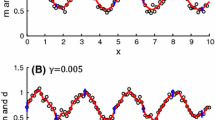Abstract
The least-squares method is presented for obtaining an overdetermined solution from the various relationships available in photoelastic stress analysis. Equations are presented for incorporating the various relations into a weighted least-squares solution and advantages of this method are illustrated in two example problems. In addition to the greater accuracy possible in the overdetermined solution, the method permits weighting of the varied information and eliminates the need to separately determine the stress-optical constant. Variations of the method are discussed.
Similar content being viewed by others
References
Businger, P. andGolub, G. H., “Linear Least Squares Solutions Using Householder Transformations, Numerische Mathematik,7,269–276 (1965).
Frocht, M. M., Photoelasticity,1,Ch. 8,John Wiley & Sons, Inc.,New York (1941).
Dally, J. W. andRiley, W. F., Experimental Stress Analysis, McGraw-Hill Book Company, Inc., New York, 236–238 (1965).
Vadovic, F., “Contribution to the Analysis of Errors in Photoelasticity,”Experimental Mechanics,5 (12),413–416 (1965).
Lewis, J. A. andPollock, H. O., “Photoelastic Calculations by a Complex Variable Method,”Zeitschrift fur Angewandte Mathematik und Physik,12,30–37 (1961).
Leland, O. M., Practical Least Squares, McGraw-Hill Book Company, Inc., New York, 17–39 (1921).
Frocht, M. M., op. cit.,.1–21 156.
Timoshenko, S. P. andGoodier, J. N., Theory of Elasticity, McGraw-Hill Book Company, Inc., New York, 22 (1951).
Thomas, G. B., Calculus and Analytical Geometry, Addison-Wesley Publishing Company, Inc., Cambridge, MA, 107–110 (1953).
Timoshenko, S. P. andGoodier, J. N., op. cit., 214.
Frocht, M. M., op. cit.,,174–175.
Dally, J. W. andRiley, W. F., op. cit.,,209–213.
Frocht, M. M., op. cit.,.
Frocht, M. M., Photoelasticity,2,John Wiley and Sons, Inc.,New York,129–134 (1948).
Ibid,,8–10.
Ibid,,240.
Berghaus, D. G., Ph.D. Thesis, Case Western Reserve University, Cleveland, OH, Appendix C (1970).
Todd, J., Survey of Numerical Analysis, McGraw-Hill Book Company, Inc., New York, 388–389 (1962).
Frocht, M. M., op. cit.,,266–268.
Isaacson, E. andKeller, H. B., Analysis of Numerical Methods, John Wiley and Sons, Inc., New York, 315–318 (1966).
Author information
Authors and Affiliations
Rights and permissions
About this article
Cite this article
Berghaus, D.G. Overdetermined photoelastic solutions using least squares. Experimental Mechanics 13, 97–104 (1973). https://doi.org/10.1007/BF02323966
Received:
Revised:
Issue Date:
DOI: https://doi.org/10.1007/BF02323966




